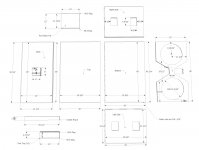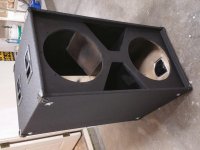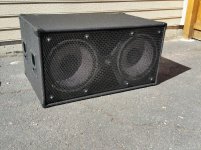Here is a design for a dual 18" sub I'm building. I have two 18-Sound TLW3000's.
I started with their recommended design, which can be found here:
http://www.eighteensound.com/Portals/0/EnclosuresKits/18sound_18_dual_subwoofer_kit.pdf
I changed the dimensions, mostly to match the width of my existing mid/high box. But, it's very close to the 18-sound design as far as volume and tuning.
Using WinISD, I've made the numbers match as close as possible to my design which is:
Exterior dimensions:
24.50" H
46.50" W
30.00" D
Internal volume (Not including braces or porting)
23.00" H = 1.92 Cu. Ft.
45.00" W = 3.75 Cu. Ft.
27.00" D = 2.25 Cu. Ft. INCLUDING 1.5" setback of the front baffle.
Internal Volume = 16.2 Cu. Ft.
Port (one, of two)
4"x 15.5" x 11.11"
Area = 92.625 In^2 = .643 Ft^2 (Both are 1.29 ft^2)
Port Length = 14"
Overall port volume = 1.29
Here's a pic, and the WinISD file as a txt file (Change .txt to .wpr to enable the file for viewing in WinISD)
3/4 inch Baltic birch plywood, thermoplastic polyurethane coating, Dado cut edges, glued and screwed. I'm going to put a good amount of insulation inside, It seems to me that the more, the better for the sound.
Opinions are welcome 🙂
I started with their recommended design, which can be found here:
http://www.eighteensound.com/Portals/0/EnclosuresKits/18sound_18_dual_subwoofer_kit.pdf
I changed the dimensions, mostly to match the width of my existing mid/high box. But, it's very close to the 18-sound design as far as volume and tuning.
Using WinISD, I've made the numbers match as close as possible to my design which is:
Exterior dimensions:
24.50" H
46.50" W
30.00" D
Internal volume (Not including braces or porting)
23.00" H = 1.92 Cu. Ft.
45.00" W = 3.75 Cu. Ft.
27.00" D = 2.25 Cu. Ft. INCLUDING 1.5" setback of the front baffle.
Internal Volume = 16.2 Cu. Ft.
Port (one, of two)
4"x 15.5" x 11.11"
Area = 92.625 In^2 = .643 Ft^2 (Both are 1.29 ft^2)
Port Length = 14"
Overall port volume = 1.29
Here's a pic, and the WinISD file as a txt file (Change .txt to .wpr to enable the file for viewing in WinISD)
3/4 inch Baltic birch plywood, thermoplastic polyurethane coating, Dado cut edges, glued and screwed. I'm going to put a good amount of insulation inside, It seems to me that the more, the better for the sound.
Opinions are welcome 🙂
Attachments
Oatmeal,I'm going to put a good amount of insulation inside, It seems to me that the more, the better for the sound.
If by "better" you mean less output, you are correct, the more insulation in a sub woofer bass reflex cabinet, the less output due to absorption.
In a "full range" cabinet, insulation will reduce out of phase mid-band frequencies coming from the port, a good thing.
Since sub woofers are band passed, they do not have mid band frequencies coming out the ports, so insulation (damping) is not required.
If you want to get historical, this was a mid 1980's thing, when the transition from woofers to sub-woofers started to make it's mark.
Your cabinet design looks OK, it could be simplified by making the ports triangular rather than trapezoidal. Adding rear "wings" to the ports increases symmetry, reducing turbulence, though will lower the Fb a bit. Another consideration would be a center divider which could be cut out for the triangular ports, having separate chambers is a good thing from a distortion and survivability aspect if one driver were to fail.
Art
Last edited:
Interesting, I will listen to it first then, I hadn't heard that damping material is passe. In other boxes I've made or used, it seems to smooth and deepen the sound somewhat(?) Is this not the case? I can lose some volume for increased quality.
Originally, I used triangles but didn't like the look (not that it matters behind a grille) but the Clair Bros. boxes I also used for inspiration had the trapezoids, and I liked the look.
I didn't center-divide because the weight is a factor. Not that a couple extra pounds are a big deal in this, but why lift it if you don't need to. I will brace the sides more than is in the drawing with some 3/4 x 1 material from leftovers.
By "rear wings" do you mean tapering and smoothing the ends of the ports?
Originally, I used triangles but didn't like the look (not that it matters behind a grille) but the Clair Bros. boxes I also used for inspiration had the trapezoids, and I liked the look.
I didn't center-divide because the weight is a factor. Not that a couple extra pounds are a big deal in this, but why lift it if you don't need to. I will brace the sides more than is in the drawing with some 3/4 x 1 material from leftovers.
By "rear wings" do you mean tapering and smoothing the ends of the ports?
Though subwoofer are not fed mid-band frequencies, the harmonic distortion created by their movement in that range can "bleed" through the ports and membrane. This is driver dependant and usually lower quality drivers create more distortion, shooting the exact effect of dampening on these drivers into the subjective realm. The absence of higher harmonics can give a 'smoother' or 'dryer' sound.
An 1 to 2" layer of insulation on the walls will typically reduce output by less then 0.5 - 1 dB, a completely (throughout) stuffed cabinet will loose 1.5 - 2 dB, to my knowledge. The latter will also add 20% virtual volume to the cabinet.
An 1 to 2" layer of insulation on the walls will typically reduce output by less then 0.5 - 1 dB, a completely (throughout) stuffed cabinet will loose 1.5 - 2 dB, to my knowledge. The latter will also add 20% virtual volume to the cabinet.
Last edited:
Ahh - Well, it could be said that the boxes I heard this work well in were equipped with very soft, long excursion drivers. These 18-Sound drivers are not that, I almost think I could stand on the cones and they wouldn't move much.
I think my volume is already enough that a 10-20% increase in virtual volume won't do much to positively affect the sound. I'll at least let the box play for a while before I stuff it and listen for differences.
*DISCLAIMER - Do not stand on your woofers*
I think my volume is already enough that a 10-20% increase in virtual volume won't do much to positively affect the sound. I'll at least let the box play for a while before I stuff it and listen for differences.
*DISCLAIMER - Do not stand on your woofers*
Some reading about stuffing/lining: Volume filling a reflex box
For sub duties, I don't bother with any stuffing/lining. Main reason being that if it breaks down or becomes loose, the driver's vents around the voicecoil will try to eat it.
Chris
For sub duties, I don't bother with any stuffing/lining. Main reason being that if it breaks down or becomes loose, the driver's vents around the voicecoil will try to eat it.
Chris
No, more like a top hat, an "L" shape on the port interior end. The port entrance and exit should also be rounded and smooth.
DSL's CS-30 port is an example of what I have attempted to verbalize, it is a rectangular port, but the same can be done with any shape.
Art
DSL's CS-30 port is an example of what I have attempted to verbalize, it is a rectangular port, but the same can be done with any shape.
Art
Attachments
The CS-30 has a CSA that looks quite a bit like a "nozzle vent", though that might not be readily apparent from first glance. That "wing" on the inside looks like the vent is just folded to go around the corner, keeping the same expansion. I was tempted to try something similar for my most recent subwoofer build, but decided that the carpentry skills/time required were a bit too much, considering the purpose that particular subwoofer was going to be used for. The "MLTL-like" approach I chose to use instead worked out fine though, with measurable vent compression only starting to take place at just under -3dB of the system's Xmax-limited linear output.
Attachments
more like a top hat, an "L" shape on the port interior end. Art
I'm afraid I don't see what you mean, are you saying to make the ports in a 90 deg. 'L' shape?The CS-30 has a CSA that looks quite a bit like a "nozzle vent", though that might not be readily apparent from first glance. That "wing" on the inside looks like the vent is just folded to go around the corner, keeping the same expansion.
...The "MLTL-like" approach I chose to use instead worked out fine though...
Why don't you make the center port one port from top to bottom. Less woodwork with just two panels, same effect and maybe better stability of the box.
Chris, that's an excellent article, thank you.
No problem. Rod Elliott's site is full of great articles - they're what I started with after joining this site.
Chris
With 2 woofers you are really missing the opportunity to take advantage of active force cancelation dramatically reducing the load on the box.
Force Cancellation: X, Y or Z axis?
You mention weight — i would not be averse to building a push-push woofer with these using 15mm plywood.
dave
Force Cancellation: X, Y or Z axis?
You mention weight — i would not be averse to building a push-push woofer with these using 15mm plywood.
dave
"ML-TL like" simulation?
Hi there B: How did you design/simulate the "ML-TL-like" vent. For TL, it seems rather short in line length. However, if it works for you, great. I've been looking at MLTL designs for bass drivers on M-H Audio and would appreciate your input on design. ...regards, Michael
....
The "MLTL-like" approach I chose to use instead worked out fine though, with measurable vent compression only starting to take place at just under -3dB of the system's Xmax-limited linear output.
Hi there B: How did you design/simulate the "ML-TL-like" vent. For TL, it seems rather short in line length. However, if it works for you, great. I've been looking at MLTL designs for bass drivers on M-H Audio and would appreciate your input on design. ...regards, Michael
I would have to make the box longer and/or wider to accommodate the necessary area. The box already has to be a certain width to match my existing mid-high, and I don't want it any taller than necessary when used on end.Why don't you make the center port one port from top to bottom. Less woodwork with just two panels, same effect and maybe better stability of the box.
With 2 woofers you are really missing the opportunity to take advantage of active force cancelation dramatically reducing the load on the box.
The sub will be for near-field monitoring (It's the bottom half of my live rig for bass guitar). Also, size and simplicity. Plus, if front-mount works for Clair Bros, it's settled in my eyes.You mention weight — i would not be averse to building a push-push woofer with these using 15mm plywood.
Thirdly, 18mm Plywood is not just for rigidity, but for sturdiness on the road. As it sits, it will be 234 LBS. Not exactly easy on backs, but I will put a dolly on it, and most shows I play are roll-only load in's.
- Status
- Not open for further replies.
- Home
- Loudspeakers
- Subwoofers
- Dual 18" sub design, Looking for suggestions / improvements







